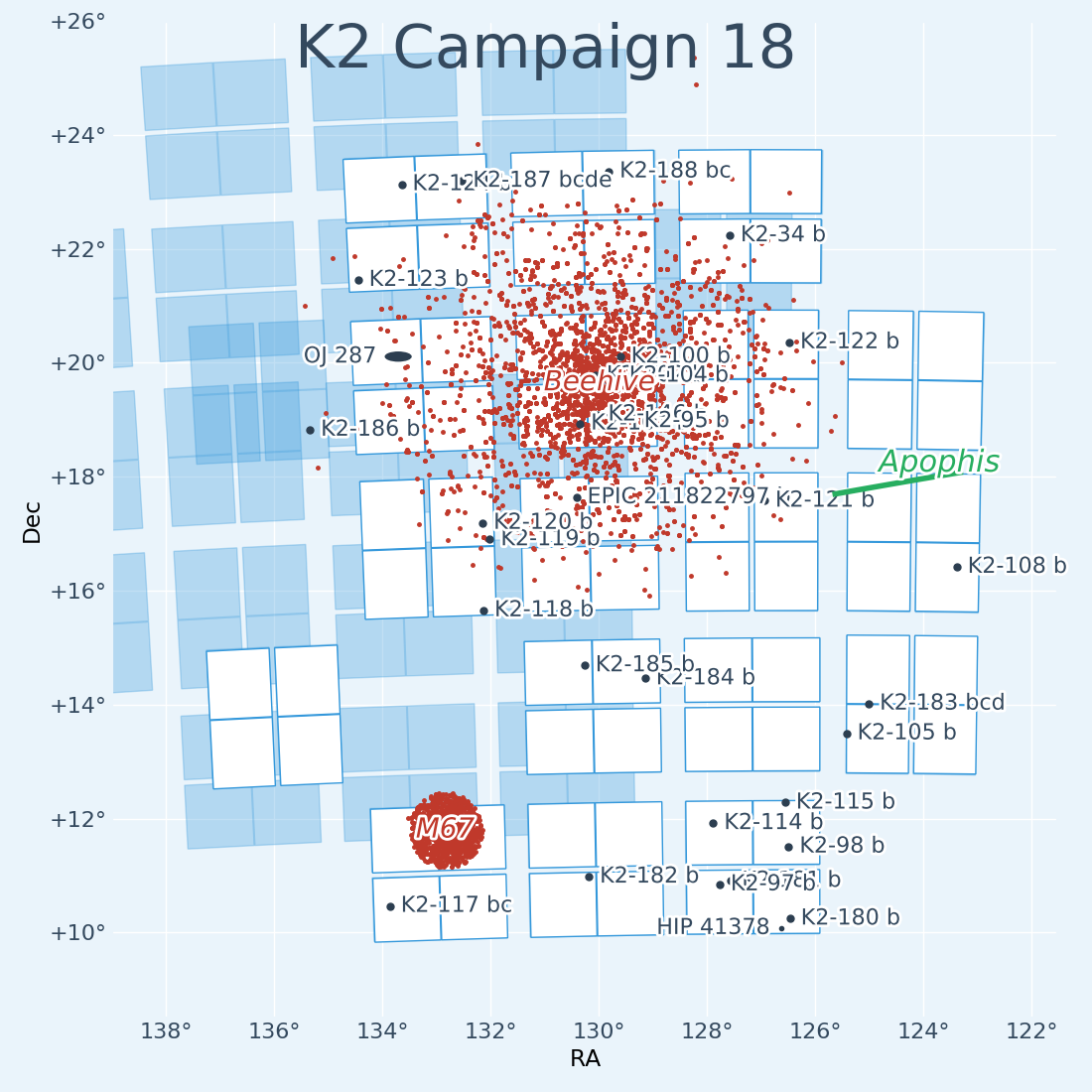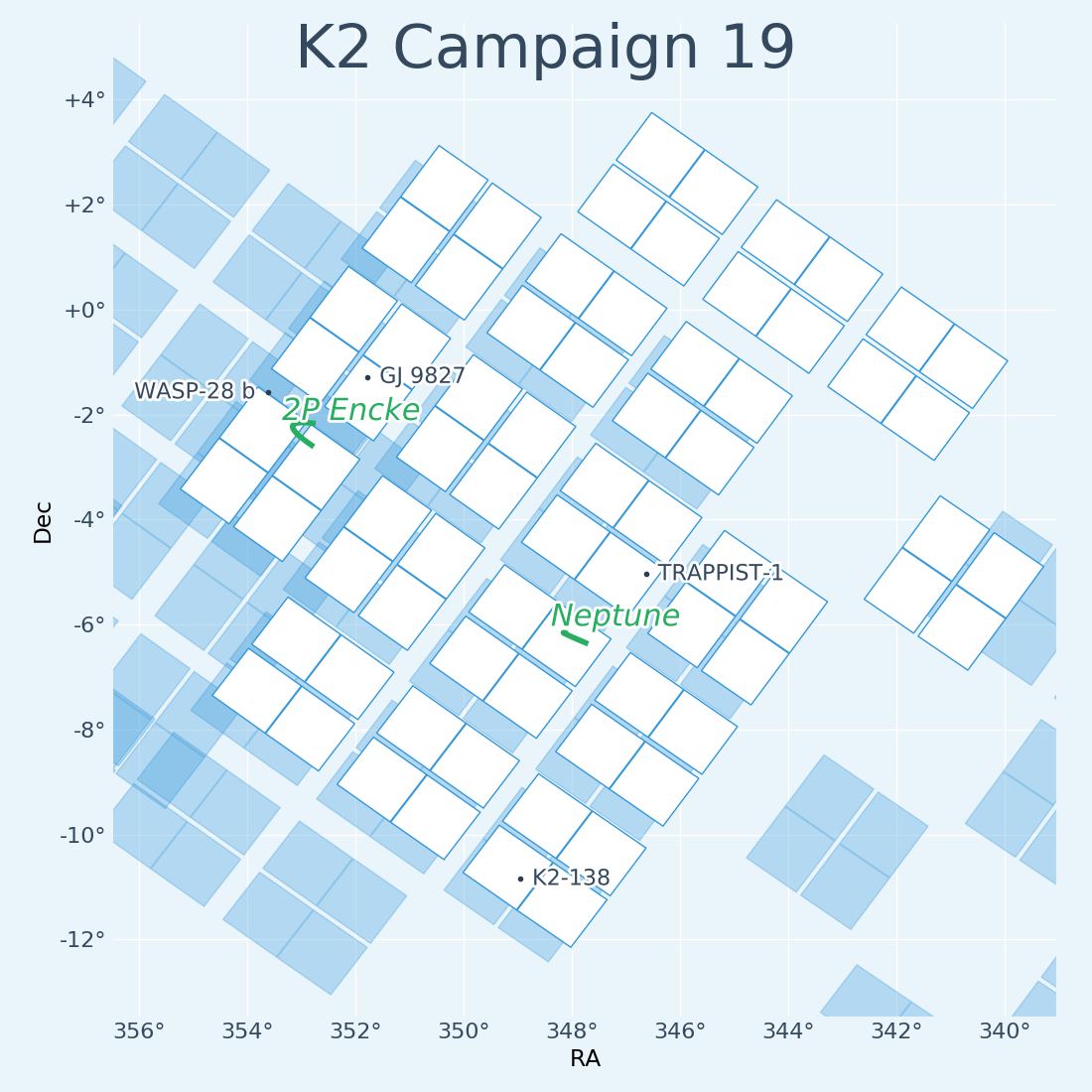Proposals for targets to be observed by K2 in Campaigns 17, 18, and 19 are currently being solicited as part of K2 Guest Observer Cycle 6, with Phase 1 submissions due on October 12, 2017.
The fields of these campaigns will cover roughly 100 square degrees each towards the constellations of Virgo (C17), Cancer (C18), and Aquarius/Pisces (C19). To help inspire observing proposals, we offer below a list of notable targets that will be visible during these campaigns.
Campaign 17
Campaign 17 (Mar 1 - May 8, 2018) will observe a forward-facing field located towards the constellation of Virgo. The high galactic latitude of this field (+55°) makes it ideally suited to survey a large number of galaxies for the K2 Supernova Cosmology Experiment. The field also provides a substantial overlap with Campaign 6, offering a longer baseline for stellar activity, asteroseismology, and AGN studies, as well as enabling dozens of known K2 planet candidates to be revisited. The field also provides access to ~20 deg2 of previously unexplored sky.
Notable objects which may be proposed include:
- Spica (V=1): the brightest star in the constellation of Virgo, known to be a rotating ellipsoidal variable with a period of four days.
- EQ Virginis (V=9): a bright K-type flare star.
- K2-41, K2-99, K2-110: stars hosting confirmed planets discovered during K2 Campaign 6.
- RX J1347.5-1145: one of the most massive galaxy clusters known.
Campaign 18
Campaign 18 (May 12 - Aug 2, 2018) will observe a backward-facing campaign dedicated to revisit Campaign 5 and substantially overlap Campaign 16. The third visit to this key part of the sky that contains the M44 and M67 clusters will enable users to study benchmark targets with a 3-year baseline and 8-month duty cycle, enabling original Kepler-like science at a Galactic sightline that is located 130 degrees away from the original Kepler field in Cygnus. The field also provides access to more than one hundred previously-published K2 planets and planet candidates.
Notable objects which may be proposed include:
- M67: the benchmark open cluster with solar-like age and metallicity.
- M44 (aka Praesepe or the Beehive): a 600 Myr-old open cluster revealed by K2 Campaign 5 to contain several planets.
- HIP 41378 (V=9): a bright F-type dwarf previously discovered by K2 to host at least 5 planets.
- K2-34, K2-95, K2-97, K2-98, K2-100, K2-101, K2-102, K2-103, K2-104, K2-105, K2-108, K2-114, K2-115: additional stars hosting confirmed K2 planets.
- OJ 287 (V=15): a well-studied galaxy thought to show lightcurve variations due to a binary supermassive black hole at its center.
Campaign 19
Campaign 19 (Aug 6 - Oct 10, 2018) will observe a forward-facing field near the constellation of Aquarius, partially overlapping Campaigns 3 and 12, while also providing access to ~15 deg2 of previously unstudied sky.
Notable objects which may be proposed include:
- Neptune: the planet.
- TRAPPIST-1 (V=19): the well-known M dwarf known to host 7 Earth-sized planets.
- GJ 9827 (V=10): a K-type dwarf recently revealed to host at least three transiting planets near the rocky/gaseous divide.
- HD 217107 (V=6): a bright G-type subgiant known to host two large RV planets.
- Comet 2P/Encke (V=20): a well-known periodic comet.
Other candidate targets
In addition to the highlights listed above, Simbad lists a wealth of known objects that will be visible during these Campaigns. They include:
- 28,857 Galaxies;
- 1,979 known M dwarfs;
- 799 High Proper-Motion stars;
- 616 White Dwarfs;
- 462 RR Lyr Variables;
- 310 Active Galactic Nuclei;
- 204 (candidate) Brown Dwarfs;
- 44 Flare Stars;
- 21 Cataclysmic Variables.
A full table containing all Simbad sources that are visible in C17-18-19 can be downloaded from this website in CSV format (K2-C17-C19-Simbad.csv) or as a VOTable (K2-C17-C19-Simbad.xml.gz). Beware however that Simbad is not a full catalog of all known sources; it merely lists objects that have previously been discussed in the literature. For the purpose of e.g. color-based target selections, we recommend using a more complete source catalog such as the EPIC.
As a reminder, the K2fov Python package enables you to test whether targets fall within a campaign field, while its sister K2ephem package allows moving Solar System bodies to be checked. Note that Campaigns 17-18-19 require K2fov version 7.0 or higher to be installed.


